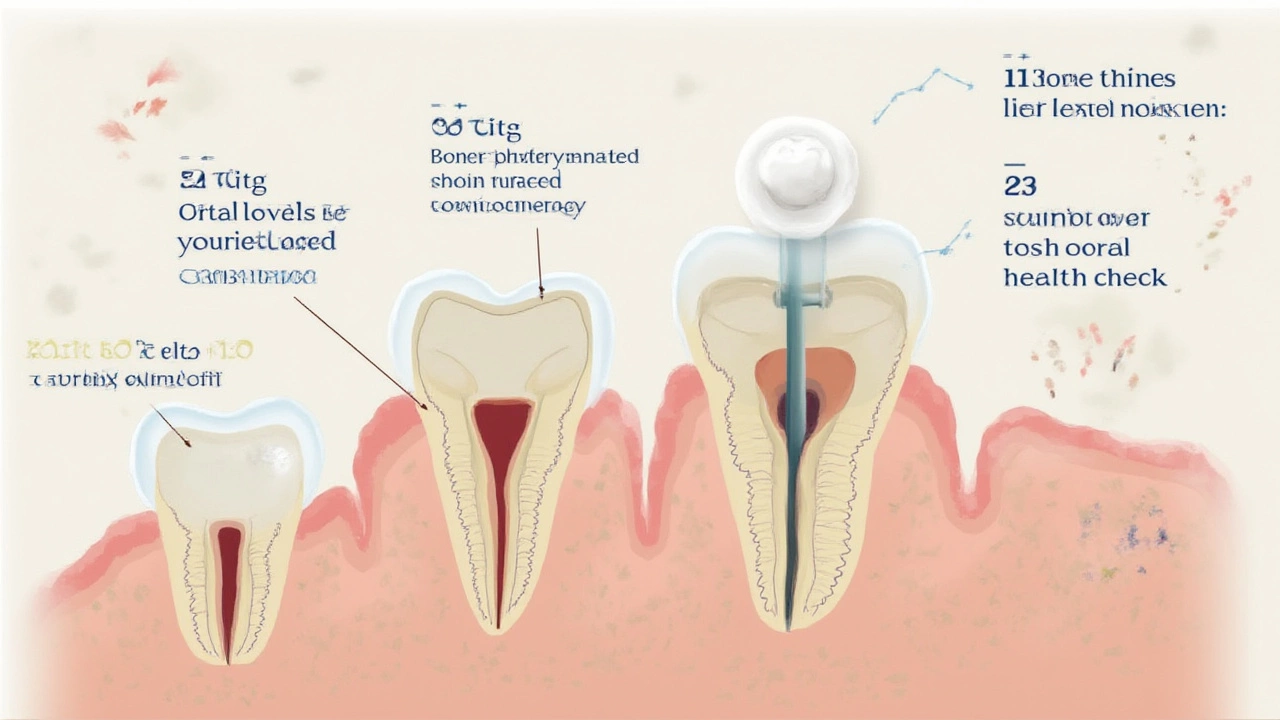
So here’s the deal: You lost a tooth two years ago and now you’re wondering if it’s too late to get a dental implant. Maybe you got tired of feeling the gap with your tongue. Maybe your dentist’s warnings about bone loss are starting to sound a bit scary. Or maybe you just want your smile back. Whatever the reason, you’re not alone. Thousands of Kiwis (and honestly, people everywhere) find themselves in this exact spot—wishing they’d taken action sooner, but hoping it’s not too late. The good news? Getting a dental implant, even two years down the track, is often totally possible. But there’s more to it than just booking an appointment and turning up. The space left by a missing tooth is a lot like an empty plot of land—if you leave it alone, things happen. And not always the things you want. But lucky for you, modern dentistry is full of possibilities, and a lost tooth isn’t the end of your smile story.
What Happens to Your Jaw After Tooth Loss?
People don’t often think about their jaw when they lose a tooth. The usual concern is how it looks, like, “Will people notice this gap when I laugh?” But what really goes on under the gum is actually way more dramatic. See, your jawbone isn’t just there to hold your teeth. It relies on your teeth for its own health and strength. Every time you bite or chew, your tooth roots send tiny signals that keep the bone alive and kicking. No tooth root means no signal – and the bone slowly packs up shop.
The technical name for what happens after a tooth extraction is 'bone resorption.' This just means your body takes away the bone it thinks you’re not using. Most of the bone loss will happen within the first six months to a year after your tooth goes, but it does keep dwindling. Data from a 2016 study published in the Journal of Periodontal & Implant Science shows that people lose around 25% of bone width in the first year after losing a tooth. That’s enough to make the area sink in or look hollow. Two years out? You might have lost up to 40%. That’s why waiting two years before thinking about a dental implant isn’t exactly ideal, but it’s also not a closed door.
You can actually see some of these effects in everyday life. Maybe your cheeks look a little sunken, or food just never seems to stay put in that gap. Sometimes your teeth start drifting into the empty space, getting all crooked. The longer you leave it, the bigger the project for your dentist and surgeon if you want to fill that spot again. But don’t panic—technology’s on your side.
Check out this quick overview of what’s happening:
| Time After Extraction | Approximate Bone Loss (%) |
|---|---|
| 6 months | 15-20% |
| 1 year | 25% |
| 2 years | up to 40% |
So when people ask if they’re still a candidate for a dental implant after two years, the bone is usually the big question. But, and this matters—a lot—you won’t know where you stand without a proper check-up. X-rays and 3D scans give your dentist the real picture. You might be surprised at how much bone you’ve got left, especially if you’re young, healthy, and take care of your teeth. On the other hand, if you smoke or had gum disease, the bone might be thinner than expected. The point is: what’s true for you won’t match your neighbour’s story.
Am I Still a Candidate for a Dental Implant?
Your biggest worry might be: Have I missed my window? It’s a fair question. Tech and materials for implants are better than ever, but they can’t magic bone back out of thin air. But here’s what’s good to know—even if you don’t have enough bone, you still might qualify, just with some extra steps.
Here’s what a dentist looks at when you enquire about getting a dental implant after two years:
- Bone volume and quality: Is there enough bone left? Is it dense enough to hold an implant in place?
- Spacing: Have your nearby teeth moved so much that there isn’t enough room? Sometimes, orthodontic treatment is needed.
- Oral health: Any gum problems or ongoing infections will need sorting out before an implant is even considered.
- Health conditions: Diabetes, osteoporosis, or smoking can slow healing or raise the risk of implant failure.
- Age: There’s no real upper age limit, as long as you’re healthy, but being younger can help with bone regeneration.
If your X-rays reveal strong bone, you might not need any extra work—just schedule the implant surgery. If there’s not enough bone, don’t write yourself off yet. Bone grafts are pretty common these days. Dentists use your own bone (from your jaw, chin, or even hip), donated bone, or special synthetic materials to rebuild the area. Sometimes, a process called 'guided bone regeneration' is used, which sounds super sci-fi but basically just involves putting a membrane over the bone to give it room to grow. It can take anywhere from three to nine months to recover from a bone graft, but people do this every single day. New Zealand dental surgeons have some of the highest success rates for implants in the world.
There are also shorter, wider, or angled implants for tricky situations. And if for some reason an implant isn’t possible, you’re not left toothless–options like bridges or partial dentures have come a long way too. Sometimes, mini-implants can work where regular ones can’t.
So, to be blunt: Two years after extraction, you’ve probably lost some bone. But with today’s dentistry, that’s just a hurdle, not a wall. Book a consult with a dentist trained in implants—they’ll give you the straight answer on what’s possible in your mouth, not just in theory.

The Dental Implant Procedure: Steps and Timeline
If you’re all-in for an implant, you might be wondering how much time you’re in for start to finish. Dental implant treatment isn’t a snap-your-fingers situation, but it’s designed to be as smooth as possible. Here’s the usual outline, broken down for a tooth extracted over two years ago:
- Assessment and planning: First, you get X-rays or a 3D CT scan. This checks bone depth and layout. Impressions or digital scanning build a model of your bite, so your new tooth looks and feels right.
- Bone grafting (if needed): No shame if your bone needs a boost. This is often a separate minor surgery. They’ll add bone material to your jaw and give it time to grow, which can take a few months up to half a year.
- Implant surgery: The big day. The dentist numbs the area. Tiny holes are drilled into the jaw for the implant post (usually titanium), which acts as your new 'tooth root.' You’ll go home with a stitched gum and pain meds – think wisdom tooth-level recovery for a few days.
- Healing (osseointegration): Here’s where patience is everything. The implant needs to fuse to the bone, a process called 'osseointegration.' This usually takes 3-6 months. You can wear a temporary tooth so nobody knows you’re in the process.
- Abutment placement: Once the post is rock-solid, the dentist attaches a small connector piece (the abutment). Another minor healing time—one or two weeks.
- Final crown: This is your new forever tooth. It gets attached to the abutment, color-matched and shaped just right. The result? You can bite into an apple or show off your smile—no one can tell the difference from the real thing.
Keeping it real: Nearly 97 out of 100 dental implants are still going strong after 10 years, according to research published in Clinical Oral Implants Research in 2024. Recovery time can feel slow, but it’s worth every week waited when you bite into something crunchy without thinking twice. If you’re worried about appointments, many Auckland clinics now do digital consultations, so you only need to show up for the big stuff.
Cost-wise, a single dental implant in New Zealand can range from $4,000 to $6,000 depending on complexity and whether you need grafts. It’s a big outlay, but patients overwhelmingly say the confidence boost makes it worth budgeting for. If money is tight, ask your dentist about payment plans or insurance – lots of clinics are flexible.
How to Make Your Implant Last: Aftercare Tips
Imagine finally getting rid of that awkward gap. You want that win to last, right? Implants are super durable, but they aren’t immortal—unless you take care of them. The biggest reason implants fail isn’t the surgery but what happens later. The mouth is full of bacteria, and implants can suffer from 'peri-implantitis,' a gum infection similar to what causes tooth loss in the first place.
Here are some practical ways to keep your implant in top shape:
- Brush twice a day—use a soft toothbrush and avoid going too wild where the implant meets your gums.
- Use floss or special interdental brushes. Even a water flosser can help. Don’t let plaque build up around your brand-new tooth.
- Go for a checkup and professional clean at least twice a year, even if you don’t have insurance. A hygienist can help spot problems before they become disasters.
- If you smoke, try to quit or cut down. Smoking basically halves your implant’s chances of long-term success.
- Skip gnawing on ice or using your teeth as a bottle opener. Implants are strong, but even titanium has limits.
- If you’re a grinder at night, ask about a night guard to protect your implant from extra pressure.
- Pay attention to your gums—tenderness, redness, or bleeding are signs to book a dentist visit right away.
People often wonder if implants get cavities. Good news—they can’t. But the gums around them can still get infected, which is just as serious. In rare cases, implants fail to fuse with the bone, but this is less likely in well-chosen, healthy candidates. Follow the aftercare plan your dentist gives you like it’s gospel. If you get sick, start new meds, or notice anything odd, mention your implant at your doctor’s appointments. Simple, clear communication keeps small issues from turning big.
One real-life tip—having a dental implant can actually motivate you to keep your whole mouth cleaner. Lots of folks find themselves taking better care of all their teeth once they’ve invested in an implant. It turns into a virtuous cycle of better check-ups and fewer dental dramas down the line.
Bottom line: you can absolutely get a dental implant after two years, as long as you’re ready to play by the rules and let your dental team guide you. The science and options keep improving, so you might be surprised what’s possible—even if you thought you had missed your shot. Give yourself the gift of a restored smile. Your future self will be grateful every time you grin, chew, or just catch yourself in the mirror and see a complete, natural look staring back.